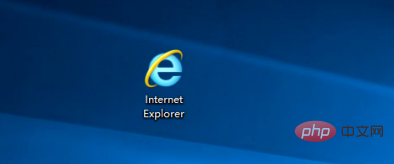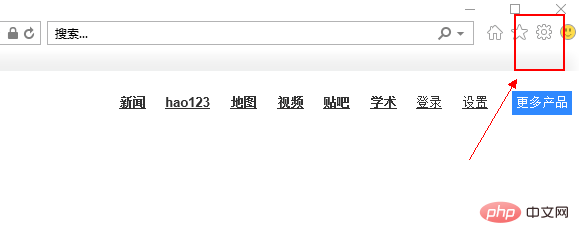Home >Common Problem >What is IE software
What is IE software
- 青灯夜游Original
- 2022-09-09 11:52:2527514browse
IE's full name is "Internet Explorer". It is a graphical user interface web browser launched by Microsoft. It is an application that displays files in a website server or file system and allows users to interact with these files. Software; it can determine the location of information resources based on links in the WWW system, retrieve the information resources that the user is interested in, interpret HTML files, and then restore text images or multimedia information.

The operating environment of this tutorial: windows7 system, Internet Explorer11, Dell G3 computer.
IE, the full name of "Internet Explorer", is a graphical user interface web browser launched by Microsoft. It was once one of the most widely used web browsers. Since 1995, it has been built into every new version of the Windows operating system as the default browser and is also an integral part of the Microsoft Windows operating system.
A web browser is an application software that displays files in a website server or file system and allows users to interact with these files. It is used to display text, images and other information on the World Wide Web or local area network. These texts or images can be hyperlinks to other websites, allowing users to browse various information quickly and easily. Most web pages are in HTML format, and some web pages require specific browsers to display correctly.
Browser (Browser) is actually a software program used to establish a connection with the WWW and communicate with it. It can determine the location of information resources based on links in the WWW system, retrieve the information resources that the user is interested in, interpret HTML files, and then restore text images or multimedia information.

In March 2015, Microsoft confirmed that it would abandon the IE brand, replace it with Microsoft Edge on Windows 10, and stop releasing security updates for versions prior to Internet Explorer 11. .
The IE development plan began in the summer of 1994. In order to resist the then mainstream Netscape browser (Netscape Navigator), Microsoft wanted to develop its own browser in Windows. But Microsoft didn't have time to start from scratch, so Microsoft teamed up with Spyglass, and IE was derived from an early commercial patented web browser, Spyglass Mosaic. Although Spyglass Mosaic was closely related to NCSA Mosaic (the first and most widely used web browser) ) is very similar, but Spyglass Mosaic is relatively unknown and uses a small amount of source code from NCSA Mosaic.
In 1995, Microsoft acquired the source code and license for Spyglass Mosaic from Spyglass in exchange for quarterly fees and a portion of the revenue. As a result, IE gradually became Microsoft's exclusive software. On August 16 of the same year, Microsoft launched the IE 1.0 browser. At the time, it was just windows 95Plus! An add-on software for the enhancement package. The typesetting engine (commonly known as the kernel) it uses is Trident. Every time a new IE version is released, it also marks an increase in the Trident kernel version number.
The Trident engine is designed as a software component (module), making it easy for other software developers to add web browsing functionality to their self-developed applications. Microsoft proposed a software interface architecture called the Component Object Model (COM). For other applications that support the Component Object Model development environment to access and edit web pages. For example, a program written in C or .NET can be added to a browser control and use the Trident engine to access the content of the web page currently displayed on the browser and the values of various elements of the web page. Events triggered from the browser control It can also be captured and processed by the program. All functions provided by the Trident engine are stored in the dynamic link library mshtml.dll.
The first few IEs all provide optional installation for the corresponding Windows in the form of software packages. Starting from IE4, IE is integrated into the latest supported version of Windows as the default browser and can support The early Windows provide installers for upgrades (the only exception is IE9, which is not integrated in its supported Windows Vista and Windows 7, while the subsequent Windows 8 directly integrates IE10, of course due to the powerful deployment images of Windows Vista and Windows 7 Management tools, users can integrate the IE9 installer into install.wim, but this is not a true integration and can only be considered an upgrade and update coverage, because "traces" of the new version of IE can still be found in installed updates, and can be uninstalled).
In addition to being the default browser for Windows, IE2-IE6 all support Apple MacOS/OS X, and IE4 and IE5 also support X Window System, Solaris and HP-UX UNIX. However, only Windows is supported since IE7. In addition, no IE supports mobile terminals. The IE on mobile terminals is actually Internet Explorer Mobile (referred to as IE Mobile). Although there is more Mobile in the name, IE Mobilie actually uses a completely different core.
How to set the default homepage of IE browser
1. Double-click the desktop icon, open IE browser, find the tool icon in the upper right corner and click it, as shown in the figure :


2. Click the tool icon to find "Internet Options" and click to enter, as shown in the picture:
3. After entering the internet options interface, we click the button [General], as shown in the following figure
FAQ column!
The above is the detailed content of What is IE software. For more information, please follow other related articles on the PHP Chinese website!




